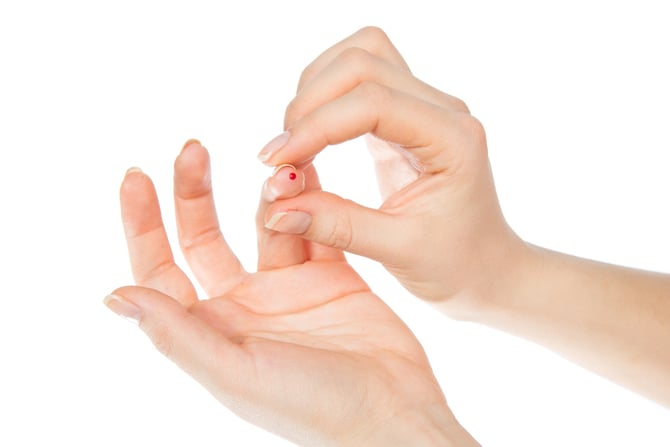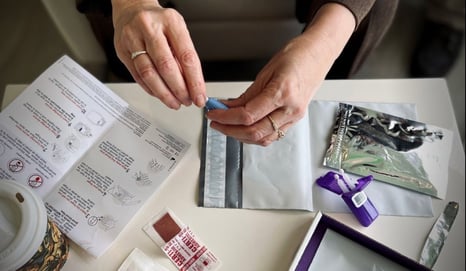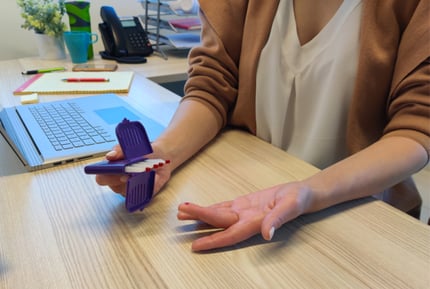Share this
capillary blood sampling applications in health and wellness
by Neoteryx Microsampling on Sep 17, 2019 4:20:00 AM

Capillary blood microsampling from the fingertip is a simple procedure that allows participants to draw their own blood in small, precise amounts. This can be done using a lancet for a quick finger-stick to produce a blood drop, which can be collected with a small, portable blood collection device. This approach makes it easy to collect blood samples anywhere, which opens the door for a host of innovations in health and wellness.
The use of finger-stick microsampling for quantitative blood sample collection is gaining traction in scientific research programs, as well as in the health and wellness industry. You may have seen a number of sample collection kits that are now available through different organizations for tracking your genealogy, fertility, or general health and wellness.
 These kits feature a do-it-yourself approach to blood sample collection at home, with the convenience of sending the self-collected samples directly to a lab for analysis.
These kits feature a do-it-yourself approach to blood sample collection at home, with the convenience of sending the self-collected samples directly to a lab for analysis.
By using the easy-to-use microsampling devices in these remote kits to draw precise, small volumes of blood from a fingertip, participants in clinical trials and health programs can take advantage of more specific testing, precision medicine, and a whole lot more in the growing health and wellness sector.
Capillary blood collection: Why is it gaining in popularity?
With the help of technology, it has become easier for medical experts to find connections and innovations in health and medicine. Among the technological advances from which medical facilities have benefited is capillary blood sampling. Capillary blood samples can be dried on filter paper or a sampling device before transporting them to the lab, where they will be analyzed using a dried blood sampling workflow.
Capillary dried blood microsampling has been used in hospitals for newborn screening for decades in the form of the dried blood spot (DBS) card. However, it took some time for capillary blood sampling to be improved as a technique and applied in a wider range of uses. Over the years, scientists, field researchers, clinical trial managers, and others have come to discover its benefits.
Two big reasons to consider capillary blood sampling are:
- It is patient-centered: According to research, patients overwhelmingly choose capillary blood sampling with a quick finger-stick over other blood sampling techniques. It’s more comfortable and quite convenient.
- It is quick and simple: Capillary blood sampling simply involves a quick prick on a fingertip using a tiny lancet and a handheld microsampling device. This avoids the stress of a venous blood draw in a clinic, and also eliminates the special handling and transport processes required with conventional liquid blood samples.
Dried Blood Microsampling Overcomes Old Limitations
Thanks to capillary blood sampling, many studies that previously required wet blood samples in tubes can now be done more easily and cost-effectively with a simple microsampling method.
/hemaPEN%20images%20for%20Review/WEB/about-collect-hemaPEN-clinic-setting_4%20copy.jpg?width=437&height=299&name=about-collect-hemaPEN-clinic-setting_4%20copy.jpg) And, with advanced technology, this method no longer requires the old-fashioned DBS cards. Newer volumetric microsampling devices like the hemaPEN® and the Mitra® device with VAMS® technology make it possible to acquire volumetrically precise, quantitative blood samples.
And, with advanced technology, this method no longer requires the old-fashioned DBS cards. Newer volumetric microsampling devices like the hemaPEN® and the Mitra® device with VAMS® technology make it possible to acquire volumetrically precise, quantitative blood samples.
Unlike conventional DBS cards, on which blood spots may dry unevenly with wide variation in sample volumes, volumetric samples are so accurate that the hematocrit bias is effectively eliminated. This means that volumetric blood microsamples can generate results that correlate with those from wet blood samples and plasma.
 Volumetric microsampling technology continues to evolve. As it evolves, more scientists and medical professionals are offering their study participants and patients the option to collect their own specimen samples at home.
Volumetric microsampling technology continues to evolve. As it evolves, more scientists and medical professionals are offering their study participants and patients the option to collect their own specimen samples at home.
This convenient remote approach may help patients avoid extra trips to the lab or clinic for a blood draw and may help clinical trials recruit more study participants who can't easily travel to a hospital or research facility for clinical trial appointments.
The blood microsampling market is expected to grow rapidly in the next few years, and we are likely to see many new and exciting applications of microsampling in the health and wellness sectors in the future.
Image credits: Trajan, iStock, Shutterstock
Share this
- Microsampling (206)
- Research, Remote Research (119)
- Venipuncture Alternative (105)
- Clinical Trials, Clinical Research (83)
- Mitra® Device (73)
- Therapeutic Drug Monitoring, TDM (51)
- Dried Blood Spot, DBS (39)
- Biomonitoring, Health, Wellness (30)
- Infectious Disease, Vaccines, COVID-19 (24)
- Blood Microsampling, Serology (23)
- Omics, Multi-Omics (21)
- Decentralized Clinical Trial (DCT) (20)
- Specimen Collection (18)
- Toxicology, Doping, Drug/Alcohol Monitoring, PEth (17)
- Skin Microsampling, Microbiopsy (14)
- hemaPEN® Device (13)
- Preclinical Research, Animal Studies (12)
- Pharmaceuticals, Drug Development (9)
- Harpera Device (7)
- Industry News, Microsampling News (5)
- Antibodies, MAbs (3)
- Company Press Release, Product Press Release (3)
- Environmental Toxins, Exposures (1)
- July 2025 (1)
- May 2025 (1)
- April 2025 (2)
- December 2024 (2)
- November 2024 (1)
- October 2024 (3)
- September 2024 (1)
- June 2024 (1)
- May 2024 (1)
- April 2024 (4)
- March 2024 (1)
- February 2024 (2)
- January 2024 (4)
- December 2023 (3)
- November 2023 (3)
- October 2023 (3)
- September 2023 (3)
- July 2023 (3)
- June 2023 (2)
- April 2023 (2)
- March 2023 (2)
- February 2023 (2)
- January 2023 (3)
- December 2022 (2)
- November 2022 (3)
- October 2022 (4)
- September 2022 (3)
- August 2022 (5)
- July 2022 (2)
- June 2022 (2)
- May 2022 (4)
- April 2022 (3)
- March 2022 (3)
- February 2022 (4)
- January 2022 (5)
- December 2021 (3)
- November 2021 (5)
- October 2021 (3)
- September 2021 (3)
- August 2021 (4)
- July 2021 (4)
- June 2021 (4)
- May 2021 (4)
- April 2021 (3)
- March 2021 (5)
- February 2021 (4)
- January 2021 (4)
- December 2020 (3)
- November 2020 (5)
- October 2020 (4)
- September 2020 (3)
- August 2020 (3)
- July 2020 (6)
- June 2020 (4)
- May 2020 (4)
- April 2020 (3)
- March 2020 (6)
- February 2020 (3)
- January 2020 (4)
- December 2019 (5)
- November 2019 (4)
- October 2019 (2)
- September 2019 (4)
- August 2019 (4)
- July 2019 (3)
- June 2019 (7)
- May 2019 (6)
- April 2019 (5)
- March 2019 (6)
- February 2019 (5)
- January 2019 (8)
- December 2018 (3)
- November 2018 (4)
- October 2018 (7)
- September 2018 (6)
- August 2018 (5)
- July 2018 (8)
- June 2018 (6)
- May 2018 (5)
- April 2018 (6)
- March 2018 (4)
- February 2018 (6)
- January 2018 (4)
- December 2017 (2)
- November 2017 (3)
- October 2017 (2)
- September 2017 (4)
- August 2017 (2)
- July 2017 (4)
- June 2017 (5)
- May 2017 (6)
- April 2017 (6)
- March 2017 (5)
- February 2017 (4)
- January 2017 (1)
- July 2016 (3)
- May 2016 (1)
- April 2016 (2)



No Comments Yet
Let us know what you think